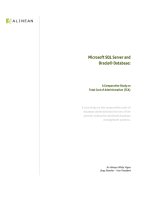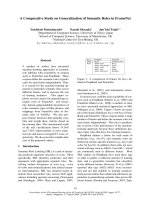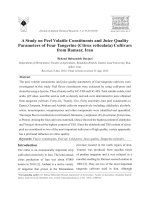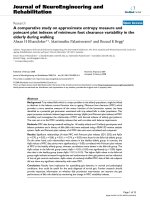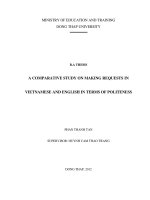Comparative study on effect of microbial cultures on soil nutrient status and growth of spinach beet in polluted and unpolluted soils
Bạn đang xem bản rút gọn của tài liệu. Xem và tải ngay bản đầy đủ của tài liệu tại đây (172.83 KB, 8 trang )
������������������������������������������������������������������������������������������������������������������������������������������������������������������������������������������������������������������������������������������������������������������������������������������������������������������������������������������������������������������������������������������������������������������������������������������������������������������������������������������������������������������������������������������������������������������������������������������������������������������������������������������������������������������������������������������������������������������������������������������������������������������������������������������������������������������������������������������������������������������������������������������������������������������������������������������������������������������������������������������������������������������������������������������������������������������������������������������������������������������������������������������������������������������������������������������������������������������������������������������������������������������������������������������������������������������������������������������������������������������������������������������������������������������������������������������������������������������������������������������������������������������������������������������������������������������������������������������������������������������������������������������������������������������������������������������������������������������������������������������������������������������������������������������������������������������������������������������������������������������������������������������������������������������������������������������������������������������������������������������������������������������������������������������������������������������������������������������������������������������������������������������������������������������������������������������������������������������������������������������������������������������������������������������������������������������������������������������������������������������������������������������������������������������������������������������������������������������������������������������������������������������������������������������������������������������������������������������������������������������������������������������������������������������������������������������������������������������������������������������������������������������������������������������������������������������������������������������������������������������������������������������������������������������������������������������������������������������������������������������������������������������������������������������������������������������������������������������������������������������������������������������������������������������������������������������������������������������������������������������������������������������������������������������������������������������������������������������������������������������������������������������������������������������������������������������������������������������������������������������������������������������������������������������������������������������������������������������������������������������������������������������������������������������������������������������������������������������������������������������������������������������������������������������������������������������������������������������������������������������������������������������������������������������������������������������������������������������������������������������������������������������������������������������������������������������������������������������������������������������������������������������������������������������������������������������������������������������������������������������������������������������������������������������������������������������������������������������������������������������������������������������������������������������������������������������������������������������������������������������������������������������������������������������������������������������������������������������������������������������������������������������������������������������������������������������������������������������������������������������������������������������������������������������������������������������������������������������������������������������������������������������������������������������������������������������������������������������������������������������������������������������������������������������������������������������������������������������������������������������������������������������������������������������������������������������������������������������������������������������������������������������������������������������������������������������������������������������������������������������������������������������������������������������������������������������������������������������������������������������������������������������������������������������������������������������������������������������������������������������������������������������������������������������������������������������������������������������������������������������������������������������������������������������������������������������������������������������������������������������������������������������������������������������������������������������������������������������������������������������������������������������������������������������������������������������������������������������������������������������������������������������������������������������������������������������������������������������������������������������������������������������������������������������������������������������������������������������������������������������������������������������������������������������������������������������������������������������������������������������������������������������������������������������������������������������������������������������������������������������������������������������������������������������������������������������������������������������������������������������������������������������������������������������������������������������������������������������������������������������������������������������������������������������������������������������������������������������������������������������������������������������������������������������������������������������������������������������������������������������������������������������������������������������������������������������������������������������������������������������������������������������������������������������������������������������������������������������������������������������������������������������������������������������������������������������������������������������������������������������������������������������������������������������������������������������������������������������������������������������������������������������������������������������������������������������������������������������������������������������������������������������������������������������������������������������������������������������������������������������������������������������������������������������������������������������������������������������������������������������������������������������������������������������������������������������������������������������������������������������������������������������������������������������������������������������������������������������������������������������������������������������������������������������������������������������������������������������������������������������������������������������������������������������������������������������������������������������������������������������������������������������������������������������������������������������������������������������������������������������������������������������������������������������������������������������������������������������������������������������������������������������������������������������������������������������������������������������������������������������������������������������������������������������������������������������������������������������������������������������������������������������������������������������������������������������������������������������������������������������������������������������������������������������������������������������������������������������������������������������������������������������������������������������������������������������������������������������������������������������������������������������������������������������������������������������������������������������������������������������������������������������������������������������������������������������������������������������������������������������������������������������������������������������������������������������������������������������������������������������������������������������������������������������������������������������������������������������������������������������������������������������������������������������������������������������������������������������������������������������������������������������������������������������������������������������������������������������������������������������������������������������������������������������������������������������������������������������������������������������������������������������������������������������������������������������������������������������������������������������������������������������������������������������������������������������������������������������������������������������������������������������������������������������������������������������������������������������������������������������������������������������������������������������������������������������������������������������������������������������������������������������������������������������������������������������������������������������������������������������������������������������������������������������������������������������������������������������������������������������������������������������������������������������������������������������������������������������������������������������������������������������������������������������������������������������������������������������������������������������������������������������������������������������������������������������������������������������������������������������������������������������������������������������������������������������������������������������������������������������������������������������������������������������������������������������������������������������������������������������������������������������������������������������������������������������������������������������������������������������������������������������������������������������������������������������������������������������������������������������������������������������������������������������������������������������������������������������������������������������������������������������������������������������������������������������������������������������������������������������������������������������������������������������������������������������������������������������������������������������������������������������������������������������������������������������������������������������������������������������������������������������������������������������������������������������������������������������������������������������������������������������������������������������������������������������������������������������������������������������������������������������������������������������������������������������������������������������������������������������������������������������������������������������������ed Soil with supply of fresh water
T1- SF Soil+FYM
30.48
46.48
T2- SF Soil+FYM+VAM+ Psuedomonas
34.02
54.05
T3- SF Soil +RDF
23.02
38.65
T4- SF Soil+RDF+FYM+VAM+Psuedomonas
39.40
60.54
Unpolluted soil with supply of fresh water
T5- SF Soil +FYM+Psuedomonas
31.30
52.30
T6- SF Soil + FYM+ VAM+Psuedomonas
39.89
64.87
T7- SF Soil+RDF
26.61
40.32
T8- SF Soil+RDF+FYM+VAM+Psuedomonas
41.63
70.03
Unpolluted soil with supply of polluted water
T9- Soil+FYM
26.40
38.12
T10- Soil+FYM+VAM+Psuedomonas
34.71
61.03
T11- Soil+RDF
28.82
50.37
T12- Soil+RDF+FYM+VAM+Psuedomonas
41.36
68.10
SE m±
0.176
0.167
C.D at 5%
0.513
0.488
1391
Int.J.Curr.Microbiol.App.Sci (2017) 6(4): 1386-1393
Table.4 Effect of microbial cultures on dry weight at 30 and 60 DAS in polluted and unpolluted
soils of spinach beet
Treatments
Dry weight of leaf/plant
30DAS
30DAS
Polluted Soil with supply of fresh water
T1- SF Soil+FYM
4.05
2.84
T2- SF Soil+FYM+VAM+ Psuedomonas
4.73
3.24
T3- SF Soil +RDF
3.16
2.22
T4- SF Soil+RDF+FYM+VAM+Psuedomonas
5.55
3.58
Unpolluted soil with supply of fresh water
T5- SF Soil +FYM+Psuedomonas
4.62
2.93
T6- SF Soil + FYM+ VAM+Psuedomonas
5.82
3.80
T7- SF Soil+RDF
3.55
2.52
T8- SF Soil+RDF+FYM+VAM+Psuedomonas
6.62
4.17
Unpolluted soil with supply of polluted water
T9- Soil+FYM
3.47
2.55
T10- Soil+FYM+VAM+Psuedomonas
5.45
3.38
T11- Soil+RDF
4.55
2.86
T12- Soil+RDF+FYM+VAM+Psuedomonas
5.97
3.95
0.046
0.03
SE m±
0.133
0.103
C.D at 5%
Among all the treatments, lowest potassium
uptake was observed in T4 (195.40 kg ha-1) in
polluted soil with application of fresh water
and highest potassium uptake was observed in
T7 (241.26 kg ha-1) in un polluted soils
application of fresh water.
The treatments applied with 100% RDF (T1,
T5, T11) through inorganic fertilizers recorded
significantly highest soil potassium at harvest
stage of the spinach crop. The treatment T3
(231.57 kg ha-1) was showed highest nitrogen
and potassium values in polluted soils with
application of fresh water than potassium
and T7 (241.26 kg ha-1) treatment was showed
highest potassium values in unpolluted soils
with application of polluted water
of inorganic, organic manures (FYM, and
biofertilizer) at 30 DAS and 60 DAS of crop
(Table 3).
The highest leaf fresh weight plant-1 was
recorded in treatment T8 (41.63 g plant-1) than
the rest of treatments at 30 DAS in unpolluted
soils. The lowest leaf fresh weight per plant
was showed in T3 (23.02 g plant-1) at 30 DAS
in polluted soils. The highest leaf fresh weight
was observed in T8 (70.03 g plant-1) and the
lowest value observed in T9 (38.12 g plant-1)
at 60 DAS in unpolluted soil. It was observed
that the treatment T8 (70.03 g plant-1)
comprising
RDF+FYM+VAM
and
Pseudomonas showed highest values at 30
DAS, 60 DAS in unpolluted soils over other
treatments.
Leaf fresh weight (g plant-1)
Leaf dry weight (g plant-1)
The data presented revealed that the leaf
fresh weight was significantly affected by
different treatments with RDF, combination
The data presented revealed that the leaf dry
weight was significantly influenced by
1392
Int.J.Curr.Microbiol.App.Sci (2017) 6(4): 1386-1393
recommended dose of fertilizers, combination
of inorganic, organic manures (FYM) and
biofertilizers (VAM and Pseudomonas) at
30DAS and 60 DAS.
The highest leaf dry weight plant-1 was
observed in T8 (6.62 g plant-1) and lowest
value in T3 (3.16 g plant-1) was observed at 30
DAS (Table 4). The highest leaf dry weight
was observed in T8 (4.17 g plant-1) and the
lowest in T3 (2.22 g plant-1) at 60 DAS.
Among all the treatments, T8 comprising
RDF, FYM, VAM and Pseudomonas was
showed highest dry weight of leaf per plant at
30 DAS and 60 DAS in unpolluted soils. In
same way, the lowest dry weight of leaf was
found in T3 at 30 and 60 DAS in polluted
soils. Similar results were reported by Madhvi
et al., (2014). It was reported that increased
leaf area and leaf dry weight in spinach was
due to application of chemical fertilizers
along with organic manures and biofertilizers.
In conclusion, it was reported that increased
leaf area and leaf dry weight in spinach was
due to application of chemical fertilizers
along with organic manures and biofertilizers.
Recycling
of
wastes
for
elements;
microorganisms abound in the soil and are
critical to decomposing organic residues and
recycling soil nutrients. Finally results
showed that unpolluted soil with the supply of
fresh water and microbial cultures was given
good results comparatively with polluted soil
with supply of fresh water and unpolluted soil
with supply of polluted water.
References
Ajay Kumar, J., Rangaswamy, E., Shivabasu
khanagoudar and Sreeramulu, K.R.
2014. Effect of Microbial Inoculants on
the Nutrient Uptake and Yield of
Beetroot (Beta vulgaris L.). Curr. Agri.
Res. J., 2(2): 123-130.
Guo, H., X. He and Y. Li. 2012. Spatial
distribution of arbuscular mycorrhiza
and glomalin in the rhizosphere of
Caragana korshinskii Kom in the
Otindag sandy land, China. Afric. J.
Microbiol. Res., 6: 5745-5753.
Jiang, W., G. Gou and Y. Ding. 2012.
Influences of arbuscular mycorrhizal
fungi on growth and mineral element
absorption of chenglu hybrid bamboo
seedlings. Pak. J. Bot., 45(1): 303- 310.
Madhavi, Y., Goud, P.V., Reddy, K.M. and
Saidulu, A. 2014. Effect of different
levels of vermicompost, castor cake,
poultry manure and biofertilizers on
growth and yield of Indian spinach
(Beta vulgaris var. bengalensis). Crop
Res., 37(1/3): 148-151.
Miller, R.M. and J.D. Jastrow. 2012. Vesicular
arbuscular
mycorrhizae
and
biogeochemical cycling, pp. 189-212.
In: Mycorrhizae and Plant Health
(Eds.): F.L. Pfleger and R.G.
Linderman. APS Press, The American
Phytopathol. Soc., St. Paul, Minnesota.
Smith, S.E. and Read, D.J. 2008. Mycorrhizal
symbiosis. 3rd ed. San Diego, CA,
USA: Academic Press.
Vessey, J.K. 2003. Plant growth promoting
rhizobacteria as biofertilizers. Plant
Soil, 255(1): 571–586,
How to cite this article:
Alavala Uma Rajashekhar, R. Subhash Reddy, M. Chandini Patnaik and Damodara Chari, K.
2017. Comparative Study on Effect of Microbial Cultures on Soil Nutrient Status and Growth
of Spinach Beet in Polluted and Unpolluted Soils. Int.J.Curr.Microbiol.App.Sci. 6(4): 13861393. doi: />
1393
